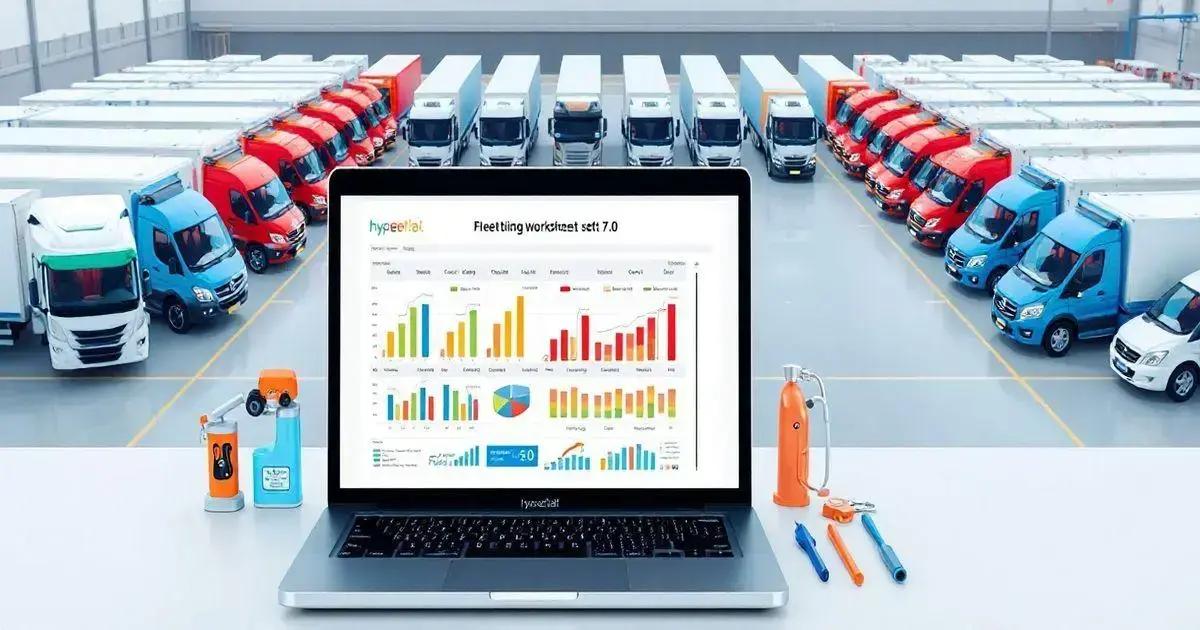Top 5 Benefits of the Fleet Control Worksheet 7.0 Leave a comment
The Fleet Control Worksheet 7.0 is a vital tool for fleet managers, offering features like vehicle maintenance tracking, fuel consumption analysis, and cost management, all designed for ease of use and efficiency. It includes a dashboard for monitoring key metrics, travel and cargo control, tire management, and expense tracking, enabling better budgeting and forecasting. Users appreciate its comprehensive functionalities, responsive support, and ability to generate visual reports, making it a valuable investment for enhancing operational efficiency and achieving cost savings in fleet operations.
Fleet management can be a complex task, but with the right tools, it becomes significantly easier. The Fleet Control Worksheet 7.0 is designed to streamline this process, providing users with comprehensive features for tracking vehicle performance, maintenance costs, and fuel consumption. Here, we’ll explore the top benefits of using this spreadsheet template to enhance your operations.
Key Features of the Fleet Control Worksheet
The Fleet Control Worksheet 7.0 is packed with an array of features designed to make fleet management as seamless as possible. Here’s a breakdown of some of its most notable functionalities:
Key Features of the Fleet Control Worksheet
- Initial Dashboard: The dashboard provides a quick overview of key metrics such as kilometers driven per driver and vehicle, fuel consumption rates, and maintenance costs. This feature allows fleet managers to see the bigger picture at a glance.
- Travel and Cargo Control: This feature tracks each trip made by your fleet, linking cargo shipments directly to their respective journeys, ensuring that nothing is left unaccounted for.
- Tire Control: Monitor tire maintenance schedules and easily identify which tires need to be replaced or serviced. This feature includes scheduling by kilometers driven, helping to prolong the life of your tires.
- Preventive and Corrective Maintenance Tracking: Keep track of all maintenance activities to ensure that vehicles are serviced on time. You can categorize maintenance into preventive and corrective types, enabling more effective budget management.
- Expense Management: The worksheet allows you to control and analyze all travel expenses, providing insights into where costs can be cut or optimized. You can also register all types of expenditures related to fuel and vehicle maintenance.
These features not only enhance operational efficiency but also provide valuable insights that can lead to cost savings in the long run. By utilizing the Fleet Control Worksheet 7.0, fleet managers can ensure their operations run smoothly and effectively.

How to Track Vehicle Maintenance
Keeping track of vehicle maintenance is crucial for ensuring the longevity and efficiency of your fleet. The Fleet Control Worksheet 7.0 simplifies this process through a structured approach. Here’s a step-by-step guide on how to effectively track vehicle maintenance using this template:
How to Track Vehicle Maintenance
- Vehicle Registration: Start by entering all your vehicles into the worksheet. Include details such as make, model, year, and vehicle identification number (VIN). This foundational step allows you to manage your fleet more effectively.
- Maintenance Schedule: Create a maintenance schedule for each vehicle. The worksheet allows you to input dates for both preventive and corrective maintenance. Set reminders for routine services like oil changes, tire rotations, and brake inspections to avoid costly repairs later.
- Log Maintenance Activities: Every time maintenance is performed, record the details in the worksheet. Include the date of service, type of maintenance, costs incurred, and any notes on the service performed. This log will help you identify patterns and recurring issues.
- Monitor Costs: Use the cost tracking feature to analyze how much you’re spending on maintenance for each vehicle. The worksheet provides an overview of total maintenance costs, helping you make informed budgeting decisions.
- Analyze Maintenance History: Review the maintenance history regularly. The worksheet allows you to pull reports on each vehicle’s performance over time, helping you identify which vehicles are becoming costly to maintain and may need to be replaced.
By following these steps, fleet managers can ensure that their vehicles are always in optimal condition, reducing downtime and extending the life of their fleet. The Fleet Control Worksheet 7.0 not only helps in keeping track of maintenance but also contributes to better decision-making regarding vehicle purchases and replacements.
Understanding Fuel Consumption Analysis
Fuel consumption analysis is a vital aspect of fleet management that helps businesses evaluate the efficiency of their vehicles and make informed decisions to reduce costs.
The Fleet Control Worksheet 7.0 offers powerful tools to track and analyze fuel usage effectively. Here’s how you can utilize this feature:
Steps for Fuel Consumption Analysis
- Input Fuel Purchases: Start by recording all fuel purchases in the worksheet. Include details such as the date of purchase, amount of fuel, price per gallon/liter, and total cost. This data will serve as the basis for your fuel consumption analysis.
- Track Mileage: For accurate fuel consumption analysis, it’s essential to log the mileage for each vehicle regularly. Record the starting and ending odometer readings for each trip. This information allows you to calculate the distance traveled and compare it against fuel used.
- Calculate Fuel Efficiency: Use the worksheet to calculate fuel efficiency (miles per gallon or kilometers per liter) for each vehicle. This can be done by dividing the total miles driven by the amount of fuel consumed. Monitoring fuel efficiency will help you identify underperforming vehicles that may need maintenance or replacement.
- Identify Patterns and Trends: The worksheet allows you to visualize fuel consumption trends over time. By analyzing this data, you can identify patterns, such as increases in fuel usage during specific months or trips. This information can inform strategies to improve fuel efficiency.
- Implement Cost-Saving Measures: Utilize the insights gained from your fuel consumption analysis to implement cost-saving measures. This may include optimizing routes, reducing idling times, or investing in fuel-efficient vehicles. Regularly reviewing fuel consumption data can lead to significant savings for your fleet.
By understanding fuel consumption analysis through the Fleet Control Worksheet 7.0, fleet managers can enhance their operations, reduce costs, and contribute to a more sustainable environment by minimizing fuel waste.

Cost Management with Fleet Control
Effective cost management is essential for maintaining a profitable fleet operation. The Fleet Control Worksheet 7.0 provides various tools and features that enable managers to track, analyze, and optimize their fleet-related expenses. Here’s how you can manage costs effectively using this powerful spreadsheet:
Cost Management with Fleet Control
- Detailed Expense Tracking: Start by recording all fleet-related expenses in the worksheet. This includes fuel costs, maintenance, repairs, insurance, and any other operational expenses. Categorizing these costs will help you get a clearer picture of where your money is going.
- Budgeting and Forecasting: Utilize the worksheet to create a budget based on historical spending data. This allows you to forecast future expenses and set realistic financial goals for your fleet. By comparing actual expenses against your budget, you can identify variances and adjust your strategies accordingly.
- Cost per Mile/Kilometer Analysis: Calculate the cost per mile or kilometer for each vehicle in your fleet. This involves dividing total expenses by the total miles driven. Monitoring this metric will help you identify which vehicles are more cost-effective and which may require further analysis.
- Analyze Maintenance Costs: Regularly review maintenance costs to gauge the reliability of your vehicles. The worksheet allows you to distinguish between preventive and corrective maintenance costs, helping you identify whether specific vehicles are becoming too expensive to maintain.
- Optimize Fleet Operations: Use the insights gained from cost management to optimize your fleet operations. This could include reducing unnecessary trips, implementing fuel-efficient driving practices, or even considering the replacement of high-maintenance vehicles. The goal is to minimize costs while maximizing productivity.
By leveraging the Fleet Control Worksheet 7.0 for cost management, fleet managers can make informed decisions that enhance operational efficiency, reduce unnecessary expenditures, and ultimately contribute to a healthier bottom line.
User Experience: Feedback and Reviews
User experience plays a pivotal role in the effectiveness of any tool, and the Fleet Control Worksheet 7.0 is no different. Feedback and reviews from users provide valuable insights into how well the worksheet meets the needs of fleet managers. Here’s an overview of user experiences:
User Experience: Feedback and Reviews
- Ease of Use: Many users appreciate the intuitive layout and user-friendly design of the worksheet. New users often report how quickly they can navigate through the different sections and enter data without needing extensive training.
- Comprehensive Features: Users frequently highlight the comprehensive features offered by the worksheet, such as fuel tracking, maintenance logging, and expense categorization. This all-in-one solution eliminates the need for multiple tools, allowing for streamlined fleet management.
- Visual Reports: The ability to generate visual reports has received positive feedback. Users find that charts and graphs make it easier to understand complex data and identify trends, which aids in making informed operational decisions.
- Customer Support: Feedback often mentions the responsive customer support provided by the developers. Users report positive experiences when seeking assistance or guidance, emphasizing that help is readily available to resolve any issues they encounter.
- Value for Money: Many fleet managers express satisfaction with the value they receive from the Fleet Control Worksheet 7.0. Users note that the insights gained from the worksheet have led to cost savings and improved efficiency, making it a wise investment for their operations.
Overall, user feedback showcases that the Fleet Control Worksheet 7.0 is an effective tool for managing fleets. Its positive user experiences reflect its ability to enhance operational efficiency, streamline processes, and contribute to better decision-making in fleet management.
Conclusion
In conclusion, the Fleet Control Worksheet 7.0 emerges as an invaluable tool for fleet managers seeking to optimize their operations.
With its comprehensive features, including detailed tracking of vehicle maintenance, fuel consumption analysis, and cost management tools, this worksheet equips users with the necessary insights to make informed decisions.
The positive user feedback highlights its user-friendly interface, robust functionality, and effective customer support, which collectively enhance the overall experience.
By implementing this worksheet, businesses can improve their fleet management practices, reduce costs, and ultimately drive greater efficiency in their operations.
For those looking to streamline their fleet management processes, investing in the Fleet Control Worksheet 7.0 promises to yield significant benefits and pave the way for more effective fleet oversight.
FAQ – Frequently Asked Questions about Fleet Control Worksheet 7.0
What features does the Fleet Control Worksheet 7.0 offer?
The worksheet offers features such as vehicle maintenance tracking, fuel consumption analysis, cost management tools, and detailed expense tracking.
Is the Fleet Control Worksheet user-friendly?
Yes, users often report that the worksheet has an intuitive design, making it easy to navigate and enter data without extensive training.
Can I customize the worksheet for my specific fleet needs?
Yes, the Fleet Control Worksheet 7.0 allows for customization to fit the unique needs of your fleet, enabling you to add specific categories or metrics.
How does the worksheet help with cost management?
The worksheet provides tools to track all fleet-related expenses, assess cost per mile/kilometer, and analyze maintenance costs to help manage and optimize budgetary concerns.
Is customer support available if I have questions?
Absolutely! The developers provide responsive customer support to assist users with any questions or issues they may encounter.
Can I access the worksheet on different devices?
The Fleet Control Worksheet is designed to work on any version of Excel; however, it does not support use on tablets or cell phones.

